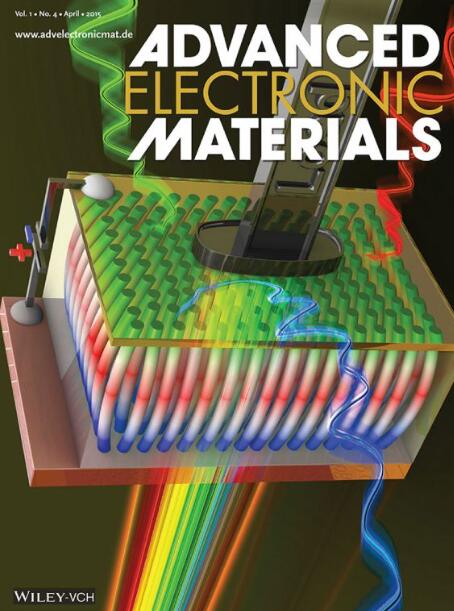Using Highly Functional Cr2O3 Interfacial Layer to Enhance the Electrical Performance of Au/InP Schottky Diodes
IF 5.3
2区 材料科学
Q2 MATERIALS SCIENCE, MULTIDISCIPLINARY
引用次数: 0
Abstract
Herein, the significant impact of the spin-coated Cr2O3 interface layer on the electrical properties and performance characteristics of Au/undoped-InP (Au/InP) Schottky diodes (SD) is reported. The material characterization of spin-coated Cr2O3 films using a wide variety of analytical techniques, namely, atomic force microscopy, field emission scanning electron microscope, X-ray diffraction, Fourier transform infrared spectroscopy, and Raman spectroscopy, indicate the formation of hexagonal phase, nanocrystalline, and stoichiometric Cr2O3 on InP. Optical absorption measurements reveal a bandgap of ≈3.5 eV. In-depth analyses and detailed measurements of current-voltage (I–V) and capacitance-voltage (C-V) employed to assess the interface characteristics and electrical performance of the Au/InP (SD) versus Au/Cr2O3/InP (MIS) devices. Compared to SD, MIS revealed superior rectifying properties. Indicating that the Cr2O3 interface layer significantly influences the barrier height (ΦBH) of SD, the estimated ΦBH (0.64 eV (I–V)/0.86 eV (C-V)) is higher than that of SD (0.57 eV (I–V)/0.67 eV (C-V)). In addition, Cheungs and Nordes' methods are used to obtain the ΦBH, ideality factor (n), and series resistance (RS). The equivalent ΦBH values obtained from current–voltage, Cheungs, and Nordes methods demonstrate stability and dependability in addition to validating their superior characteristics of MIS devices. The interface state density (NSS) for MIS is lower than the SD's, indicating that the effectiveness of Cr2O3 layer significantly reduces NSS. Analyses to probe the mechanism demonstrate that, in SD and MIS, the Schottky emission controls the higher bias area, while the Poole-Frenkel emission dominates the reverse conduction mechanism at the lower bias region. The present work convincingly demonstrates the potential application of the Cr2O3 interfacial layer in delivering the enhanced performance and contributes to the progression of electrical devices for emerging electronics and energy-related applications.

利用高功能Cr2O3界面层提高Au/InP肖特基二极管的电性能
本文报道了自旋涂覆Cr2O3界面层对Au/未掺杂InP (Au/InP)肖特基二极管(SD)电学性能和性能的显著影响。利用原子力显微镜、场发射扫描电镜、x射线衍射、傅里叶变换红外光谱和拉曼光谱等多种分析技术对自旋涂覆Cr2O3薄膜的材料进行表征,表明在InP上形成了六方相、纳米晶和化学计量的Cr2O3。光学吸收测量显示带隙约为3.5 eV。深入分析和详细测量电流电压(I-V)和电容电压(C-V),用于评估Au/InP (SD)与Au/Cr2O3/InP (MIS)器件的接口特性和电气性能。与SD相比,MIS具有更好的整流性能。表明Cr2O3界面层对SD的势垒高度(ΦBH)有显著影响,其估计值ΦBH (0.64 eV (I-V)/0.86 eV (C-V))高于SD (0.57 eV (I-V)/0.67 eV (C-V))。此外,还采用了cheung和Nordes的方法获得了ΦBH、理想因子(n)和串联电阻(RS)。从电流-电压、cheung和Nordes方法获得的等效ΦBH值除了验证其MIS器件的优越特性外,还证明了稳定性和可靠性。MIS的界面态密度(NSS)低于SD,表明Cr2O3层的有效性显著降低了NSS。机理分析表明,在SD和MIS中,高偏置区由肖特基发射控制,低偏置区由普尔-弗伦克尔发射控制。目前的工作令人信服地证明了Cr2O3界面层在提供增强性能方面的潜在应用,并有助于新兴电子和能源相关应用的电气设备的发展。
本文章由计算机程序翻译,如有差异,请以英文原文为准。
求助全文
约1分钟内获得全文
求助全文
来源期刊

Advanced Electronic Materials
NANOSCIENCE & NANOTECHNOLOGYMATERIALS SCIE-MATERIALS SCIENCE, MULTIDISCIPLINARY
CiteScore
11.00
自引率
3.20%
发文量
433
期刊介绍:
Advanced Electronic Materials is an interdisciplinary forum for peer-reviewed, high-quality, high-impact research in the fields of materials science, physics, and engineering of electronic and magnetic materials. It includes research on physics and physical properties of electronic and magnetic materials, spintronics, electronics, device physics and engineering, micro- and nano-electromechanical systems, and organic electronics, in addition to fundamental research.
 求助内容:
求助内容: 应助结果提醒方式:
应助结果提醒方式:


